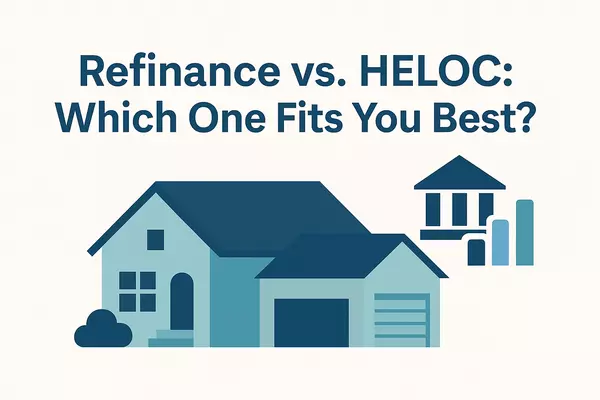Refinance or HELOC? Here's How to Decide

Many homeowners have built significant equity over the last few years. At some point, most ask the same question: Should I refinance my mortgage or take out a HELOC?
The short answer is that it depends on your goals, timeline, and current loan. Let’s break down what each option means, how they differ, and when one might make more sense than the other.
What Is a Refinance?
When you refinance, you replace your existing mortgage with a new one. Many people do this to secure a better interest rate, change the loan term, or take cash out for other purposes.
If you choose a cash-out refinance, you borrow more than you owe, take the difference in cash, and start a new loan with new terms.
Key points:
-
The interest rate is typically fixed.
-
You start a new loan term, such as 15, 20, or 30 years.
-
Closing costs are similar to those from your original mortgage.
What Is a HELOC?
A Home Equity Line of Credit, or HELOC, lets you borrow against your home’s equity as needed. It functions much like a credit card but at a much lower interest rate, and it uses your home as collateral.
Key points:
-
You are given a credit limit and can borrow as needed.
-
You only pay interest on the amount you use.
-
Most HELOCs have variable interest rates.
-
The setup costs are generally lower than a refinance.
When a Refinance Might Be the Better Choice
-
You can secure a significantly lower rate than your current mortgage.
-
You plan to stay in your home long enough to recover the closing costs.
-
You need a large sum of money upfront.
-
You want to consolidate multiple loans into a single fixed-rate mortgage.
Example:
Maria owes $150,000 on her home and wants $75,000 for a full renovation. Her current rate is 6.5%. A lender offers her a 5.2% rate on a new 30-year mortgage. The refinance gives her the funds she needs and lowers her long-term rate, so the numbers make sense for her situation.
When a HELOC Might Be the Smarter Move
-
You already have a great mortgage rate and do not want to lose it.
-
You only need access to funds occasionally or over time.
-
You prefer flexibility in borrowing and repayment.
-
You plan to sell or refinance again in a few years.
Example:
James has a mortgage at 3.25%. He wants to remodel his kitchen and expects to spend $30,000 over the next year. A HELOC allows him to draw money in stages, repay it as he goes, and avoid replacing his low-rate mortgage.
Risks and Considerations
-
Variable rates: HELOC rates can rise as market rates increase.
-
Closing costs: Both options can have fees that reduce the benefit of small loans.
-
Approval: You will need sufficient credit, income, and equity to qualify.
-
Equity risk: Borrowing too much can put your home at risk if your situation changes.
-
Taxes: Some interest may be deductible, depending on how the funds are used. Talk with your tax advisor for guidance.
Real-World Examples
-
The Remodeler: Needs $25K for home updates over the next year. A HELOC offers flexibility and low upfront costs.
-
The Debt Consolidator: Wants to pay off $80K in high-interest debt. A cash-out refinance simplifies payments and locks in a lower fixed rate.
-
The Long-Term Homeowner: Plans to stay for decades and can lower their interest rate through refinancing.
-
The Short-Term Seller: Plans to sell in two years and needs short-term access to funds. A HELOC is likely the better choice.
The Bottom Line
There is no one-size-fits-all answer. It depends on your goals, your current mortgage rate, and how long you plan to stay in your home.
If you are unsure which is right for you, I can connect you with a trusted lender who can run the numbers and help you compare both options. The right move can save you thousands over time.
Categories
Recent Posts










